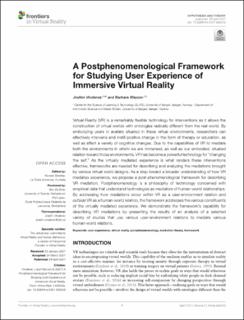| dc.contributor.author | Vindenes, Joakim | |
| dc.contributor.author | Wasson, Barbara | |
| dc.date.accessioned | 2022-02-08T13:50:39Z | |
| dc.date.available | 2022-02-08T13:50:39Z | |
| dc.date.created | 2022-01-31T14:52:44Z | |
| dc.date.issued | 2021 | |
| dc.identifier.uri | https://hdl.handle.net/11250/2977747 | |
| dc.description.abstract | Virtual Reality (VR) is a remarkably flexible technology for interventions as it allows the construction of virtual worlds with ontologies radically different from the real world. By embodying users in avatars situated in these virtual environments, researchers can effectively intervene and instill positive change in the form of therapy or education, as well as affect a variety of cognitive changes. Due to the capabilities of VR to mediate both the environments in which we are immersed, as well as our embodied, situated relation toward those environments, VR has become a powerful technology for “changing the self.” As the virtually mediated experience is what renders these interventions effective, frameworks are needed for describing and analyzing the mediations brought by various virtual world designs. As a step toward a broader understanding of how VR mediates experience, we propose a post-phenomenological framework for describing VR mediation. Postphenomenology is a philosophy of technology concerned with empirical data that understand technologies as mediators of human-world relationships. By addressing how mediations occur within VR as a user-environment relation and outside VR as a human-world relation, the framework addresses the various constituents of the virtually mediated experience. We demonstrate the framework's capability for describing VR mediations by presenting the results of an analysis of a selected variety of studies that use various user-environment relations to mediate various human-world relations. | en_US |
| dc.language.iso | eng | en_US |
| dc.publisher | Frontiers Media | en_US |
| dc.rights | Navngivelse 4.0 Internasjonal | * |
| dc.rights.uri | http://creativecommons.org/licenses/by/4.0/deed.no | * |
| dc.title | A Postphenomenological Framework for Studying User Experience of Immersive Virtual Reality | en_US |
| dc.type | Journal article | en_US |
| dc.type | Peer reviewed | en_US |
| dc.description.version | publishedVersion | en_US |
| dc.rights.holder | Copyright 2021 Vindenes and Wasson | en_US |
| dc.source.articlenumber | 656423 | en_US |
| cristin.ispublished | true | |
| cristin.fulltext | original | |
| cristin.qualitycode | 1 | |
| dc.identifier.doi | 10.3389/frvir.2021.656423 | |
| dc.identifier.cristin | 1995010 | |
| dc.source.journal | Frontiers in Virtual Reality | en_US |
| dc.identifier.citation | Frontiers in Virtual Reality. 2021, 2, 656423. | en_US |
| dc.source.volume | 2 | en_US |

